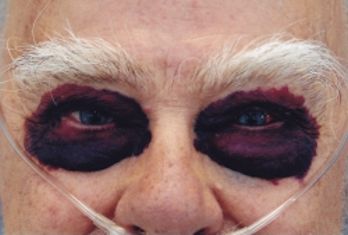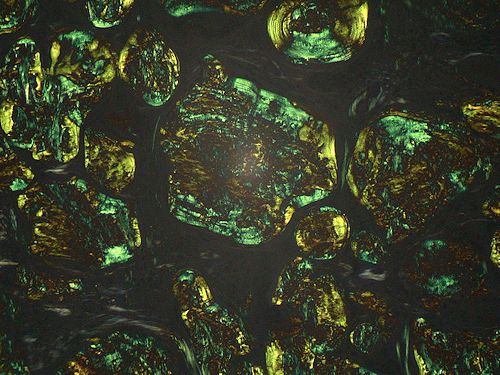
![]()
Congo Red
A red dye, but not from the Congo
![]()
![]()
Molecule of the Month January 2016
Also available: HTML version.

 |
Congo RedA red dye, but not from the Congo
Molecule of the Month January 2016 |
 |
![]()
Germany.
Well, it’s a red dye, but the Congo part is a longer story. Until only about 150 years ago, only natural dyes were available to be used to colour clothes and linen. This led to a very limited range of colours, and rather drab looking clothes. This all changed in 1857 when William Henry Perkin created the first synthetic aniline dye, a purple colour he called mauvine (which was the subject of the very first Molecule of the Month page back in Jan 1996). Very soon, European chemists (most of them German) were making a range of brightly coloured aniline dyes, and for the first time clothes and fabrics took on a rainbow of bright colours.
Wait for it. The problem with these early aniline dyes was that they tended to dissolve away on washing, and so would gradually fade. To stop this, the dye needed to be fixed permanently to the fabrics using a chemical called a mordant. But this added an expensive and costly extra step to the dyeing process.
This was solved in 1883, when a young German chemist called Paul Böttinger created a bright-red dye that stained fibres without needing a mordant. Böttinger took his discovery to his supervisors at the company where he worked (The Friedrich Bayer Company), but they dismissed it because it was the ‘wrong colour’. At the time the company wanted to find an alternative to the expensive natural dye indigo, i.e. a competitor for mauveine, so a red dye wasn’t wanted.
|
Feeling let down by his company, Böttinger went to Poland and obtained a patent for his new dye in his own name. He then offered the patent rights to three chemical companies, including his old company Bayer. All 3 rejected it, but he eventually managed to sell it to a small Berlin-based dye manufacturing company called AGFA, who were direct rivals to Bayer.
 Sounds like poetic justice…
Sounds like poetic justice…Yes, especially as AGFA went on to make a fortune with this dye, selling it all over the world under the tradename Congo Red. In fact, this product was so successful that many other dye manufacturers went out of business, unable to compete. Even Bayer nearly went out of business, but was saved in the nick of time by invention of their own direct dye, which was actually just a modified version of Congo Red.
As you can imagine, AGFA weren’t happy, and threatened to sue Bayer for patent breach. But after long drawn-out discussions, the two companies agreed a settlement in which they shared the profits from each other’s dyes – so avoiding a costly legal battle.
It is believed that this was due to political events in the world at the time the dye was first marketed. For 4 months from November 1885, Berlin hosted a major international meeting called the Berlin West Africa Conference, whose aim was to sort out a trade dispute between the various European countries rapidly colonising Africa, and in particular in the region around the Congo River basin. The ‘Congo conference’ as it became known made headlines around Europe, and the newspapers were full of debates and opinions about what was being said there, and also about other colonial issues in Africa. It was a particularly popular subject in Germany, which had just established its first African colony only that same year. In the conference, the colonial powers were actually deciding amongst themselves how to carve up the African continent (without going to war with each other), in what later became known as the ‘Scramble for Africa’.
You might imagine so, but that’d be incorrect. In fact, most traditional native textiles from the Congo River basin at that time were normally black, and almost never red.
Nope - it’s mainly derived from coal-tar waste products.

Congo red dye can be used as a pH indicator too. Below pH 3.0 it appears blue, but above pH 5.2 it’s brilliant red.
It’s believed that the marketing people at AGFA (a Berlin-based company, remember) came up with the name Congo Red for their new sensational dye because, to Europeans in 1885, the Congo was seen as an exotic place, a land of mystery, and the name ‘Congo’ was currently on the tip of every tongue due to the world-famous conference. It was simply a marketing ploy.
 And this worked?
And this worked?Well, it made Congo Red one of the most famous and widely used dyes ever. And this marketing trick was employed many times by many different companies. By 1910, there were textile dyes called Congo rubine, Congo corinth, brilliant Congo, Congo brown, Congo orange, and Congo blue, none of which had anything to do with the Congo. Similarly another range of dyes was named after another exotic African country (Sudan I-IV, Sudan Red, Sudan Black). There was also Bismarck brown, a dye named after the Chancellor Otto von Bismarck who represented Germany at the Congo Conference.
Yes, but not so much as a fabric dye. Even though it was supposedly fixed onto the fabric, it still had a tendency to change colour when touched by sweaty (acidic) fingers. It also stained other garments when washed together, so that one red sock washed with a bunch of white clothes would turn everything pink. Nowadays its main use is as a tissue stain, to reveal amyloid protein.
Amyloid proteins are ones which fail to fold up correctly. Normally proteins are soluble in water, but if they fold incorrectly they become insoluble and build up in organs or tissues, disrupting their normal function. This leads to amyloidosis, of which there are many different types, depending upon which protein and which tissues are involved. Two of the most common forms of amyloidosis involve a swelling of the tongue, or a bruising of the skin around the eyes (so-called ‘racoon eyes’), as in the images below.


Symptoms of amyloidosis. Left: Enlarged tongue. Right: ‘Racoon eyes’ or ‘panda eyes’.
Diagnosing amyloidosis can be tricky, as the amyloid proteins are almost identical to normal proteins. To do so, a biopsy is taken of the suspected tissue, which is then stained with Congo Red. When viewed under polarised light, the stained amyloid proteins are revealed as apple-green.

Lymph node amyloidosis stained with Congo red and viewed using a polarizer
(Photo: Ed Uthman, MD - Licensed under CC BY-SA 2.0 via Wikimedia Commons)
So what started out as a simple fabric dye is now a vital part of a disease diagnosis.
![]()
![]()